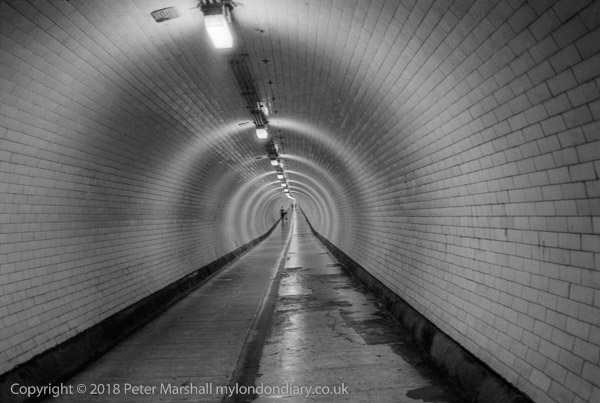London 1981
Peter MARSHALL

Woolwich Foot Tunnel, Woolwich, 1981
29e-14: tunnel, Thames, Greenwich
You can click on the image to go to the next picture
The Woolwich Foot Tunnel was opened in 1912 and is around a third of a mile long, under the Thames connecting Woolwich with North Woolwich, then a part of Woolwich and Kent on the north bank of the Thames, but now in Newham. It was of particular use for dockers working in the Royal Docks and living in Woolwich on days when the free ferry was unable to run, and its building was in part due to the lobbying of former dock worker Will Crooks, one of London's first Labour members on the London County Council who was for some years chair of the LCC Bridges Committee. He was elected as MP for Woolwich in 1902, only the fourth Labour MP and remained in Parliament (apart from a short break between the two 1910 elections) until 1921.
Both entrances to the tunnel are listed, and that in the south bank is the only remaining riverside building of Old Woolwich. Back in the 1980s it seemed usual for the lifts in both entrances to be out of order, but there was extensive renovation of the tunnel and lifts in 2010 to 2011 - which included providing a mobile phone signal in it.
The tunnel which had been relatively little used back in the 1980s as the docks and other industries in North Greenwich had largely closed now has a steadily increasing footfall as more new housing is built in the area. With the Woolwich Free Ferry closure for some months recently it will have seen more, though the DLR now provides an alternative route.
Local bylaws prohibit cycling, skateboarding and rollerskating in the tunnel, but these are seldom enforced, and a 2014 survey by FOGWOFT (Friends of Greenwich & Woolwich Foot Tunnels) found that around half of the users were cyclists, 80% of whom failed to dismount. It also found a good majority of users favoured "24-hour considerate shared use, which implies absolute priority for pedestrians" which appears to be the de-facto situation. Cyclists are encouraged to walk when the tunnel is busy - and it does have its own morning and evening rush hours.
Back in 1981 when the lifts were working, the lift operators also attempted to enforce the no-cycling rule, though it was easy to see when the lifts and operators were at tunnel level and dismount. You can't see from one end to the other as the tunnel is lower in the middle.
A blog post a few years ago, taken up widely in the press, suggested that the tunnel was a portal with a curious anomaly in which time 'stops', experienced particularly by the workers involved in its refurbishment. I didn't notice this, but did find the tunnel pleasantly cool in hot weather, but perhaps it could explain why the work took twice as long as planned. The blog post concludes: "The tunnel was re-opened in early 2012. No time-discrepancies have been reported since that date."
Both entrances to the tunnel are listed, and that in the south bank is the only remaining riverside building of Old Woolwich. Back in the 1980s it seemed usual for the lifts in both entrances to be out of order, but there was extensive renovation of the tunnel and lifts in 2010 to 2011 - which included providing a mobile phone signal in it.
The tunnel which had been relatively little used back in the 1980s as the docks and other industries in North Greenwich had largely closed now has a steadily increasing footfall as more new housing is built in the area. With the Woolwich Free Ferry closure for some months recently it will have seen more, though the DLR now provides an alternative route.
Local bylaws prohibit cycling, skateboarding and rollerskating in the tunnel, but these are seldom enforced, and a 2014 survey by FOGWOFT (Friends of Greenwich & Woolwich Foot Tunnels) found that around half of the users were cyclists, 80% of whom failed to dismount. It also found a good majority of users favoured "24-hour considerate shared use, which implies absolute priority for pedestrians" which appears to be the de-facto situation. Cyclists are encouraged to walk when the tunnel is busy - and it does have its own morning and evening rush hours.
Back in 1981 when the lifts were working, the lift operators also attempted to enforce the no-cycling rule, though it was easy to see when the lifts and operators were at tunnel level and dismount. You can't see from one end to the other as the tunnel is lower in the middle.
A blog post a few years ago, taken up widely in the press, suggested that the tunnel was a portal with a curious anomaly in which time 'stops', experienced particularly by the workers involved in its refurbishment. I didn't notice this, but did find the tunnel pleasantly cool in hot weather, but perhaps it could explain why the work took twice as long as planned. The blog post concludes: "The tunnel was re-opened in early 2012. No time-discrepancies have been reported since that date."